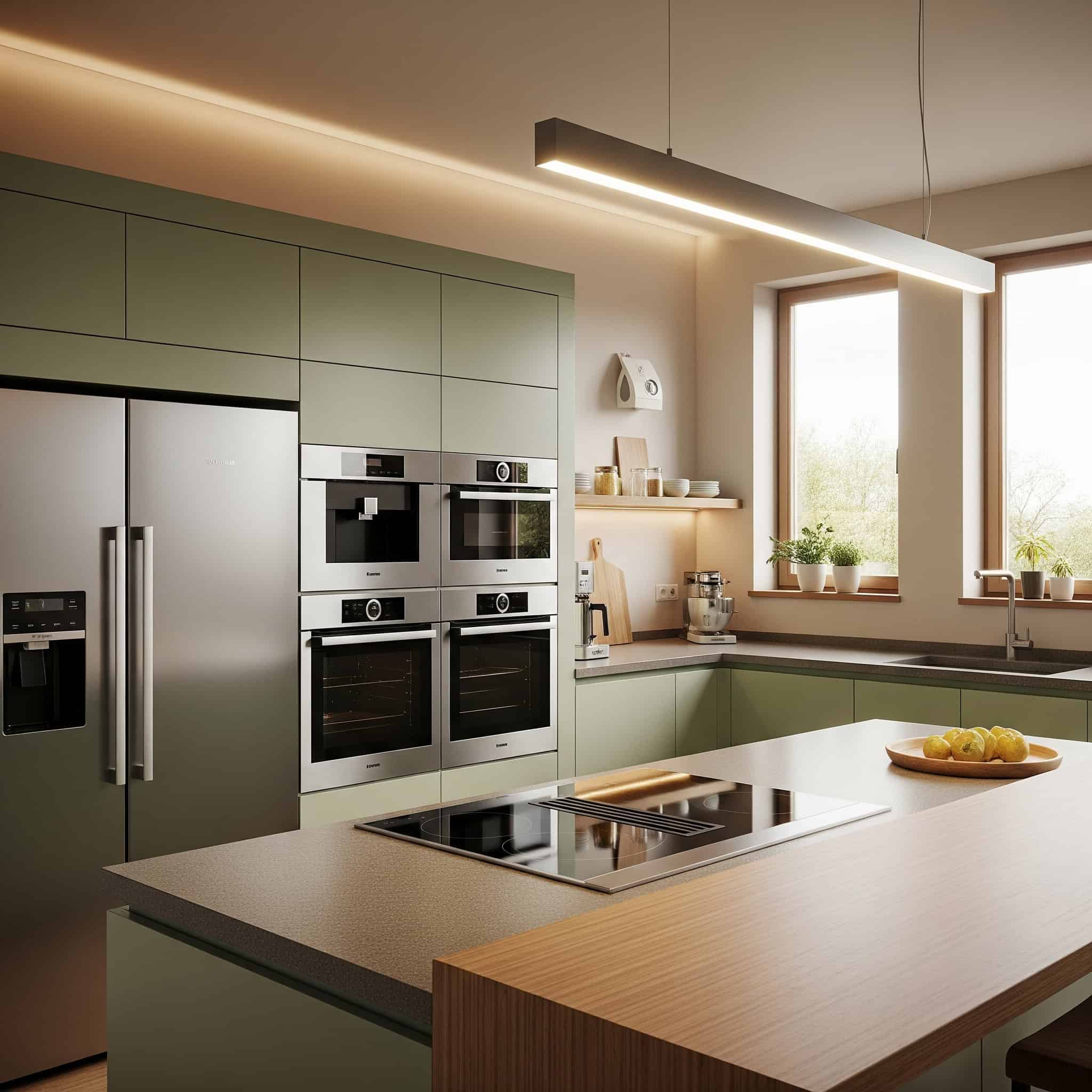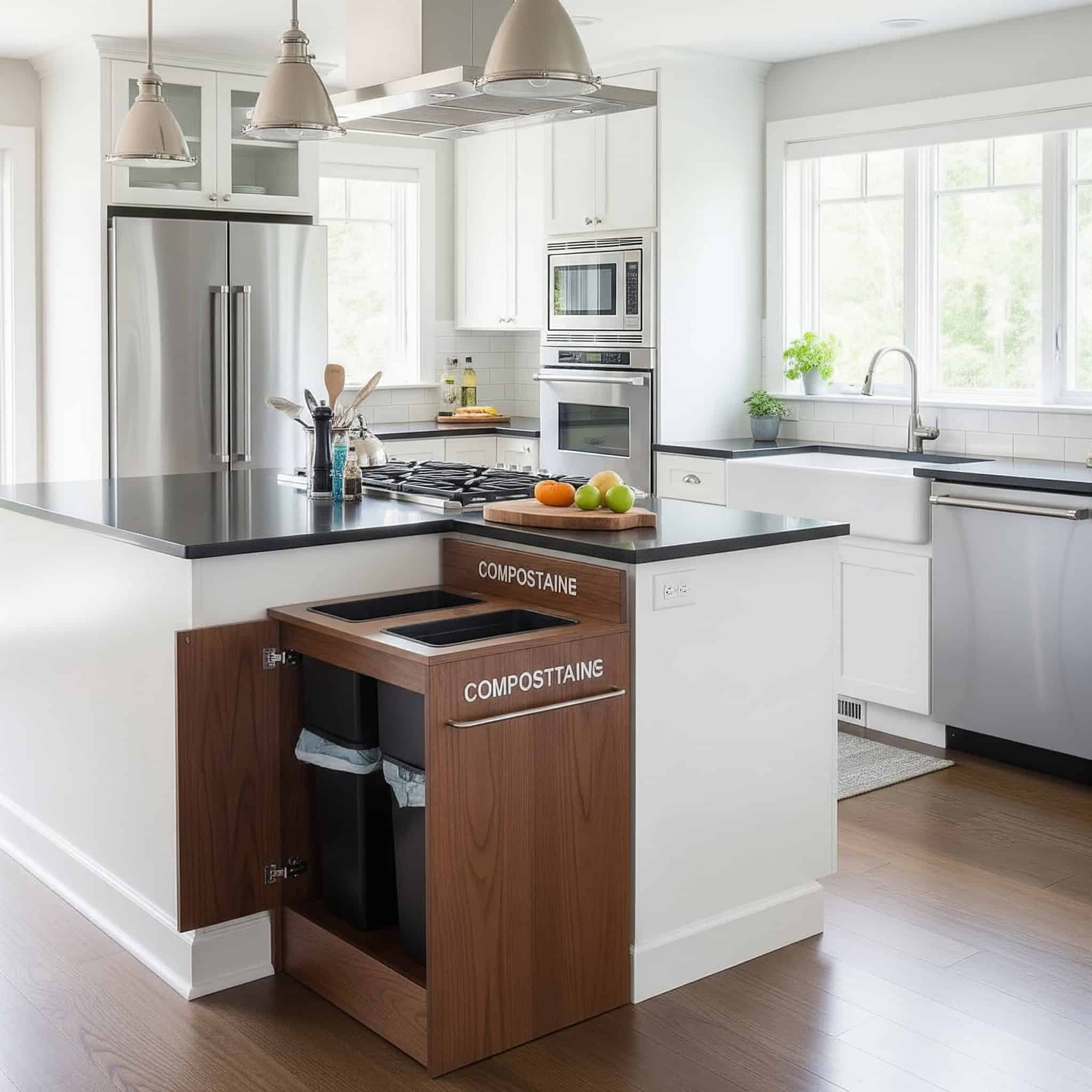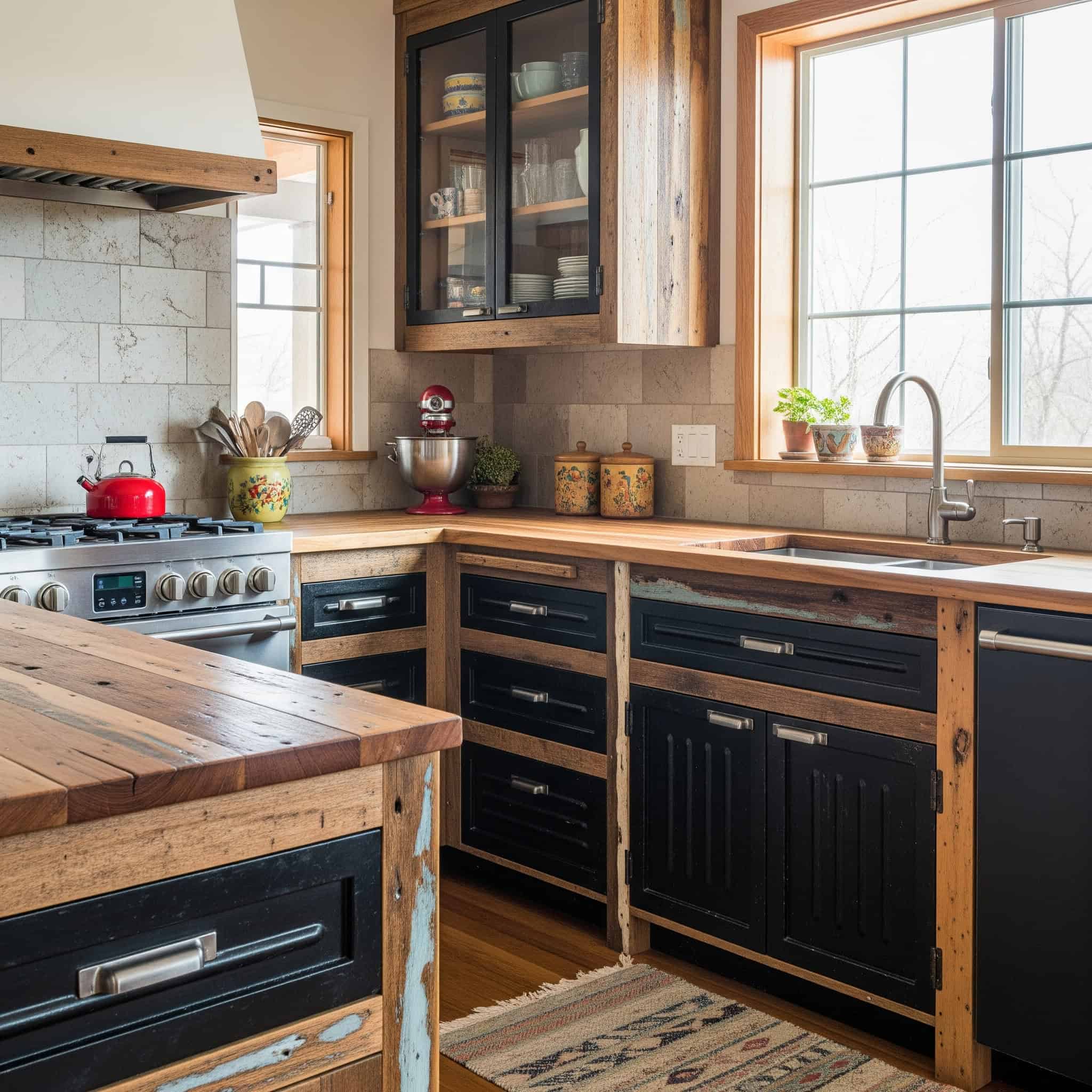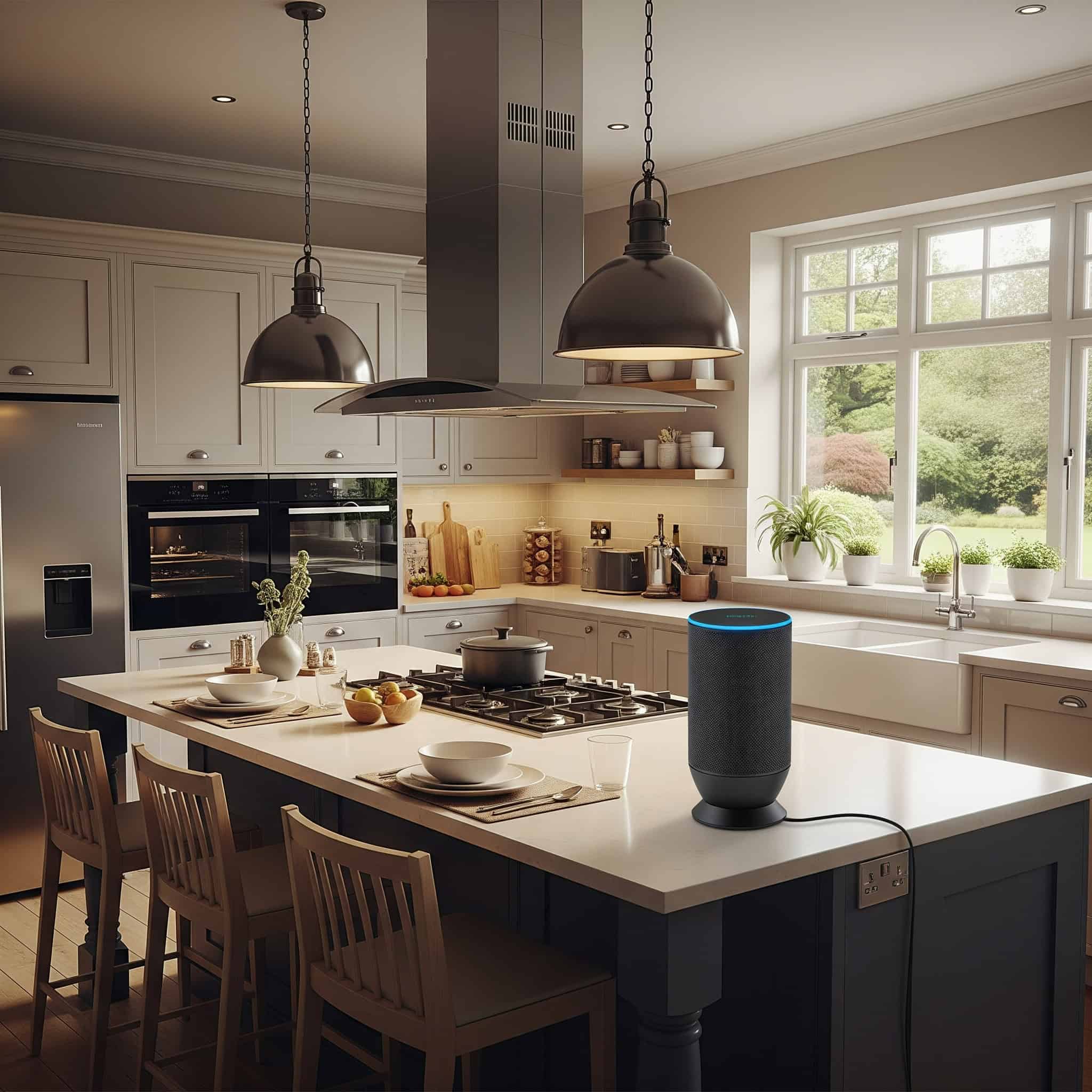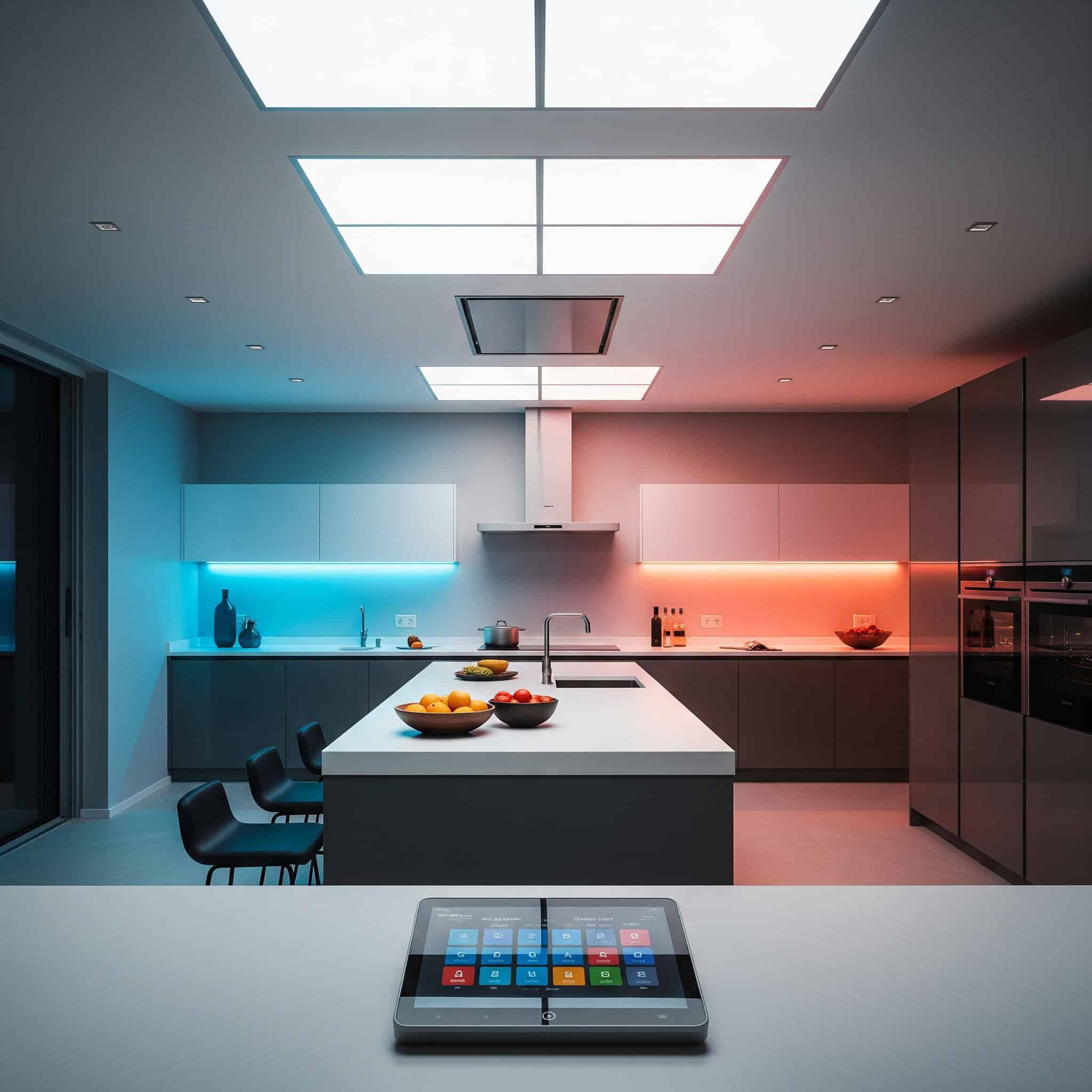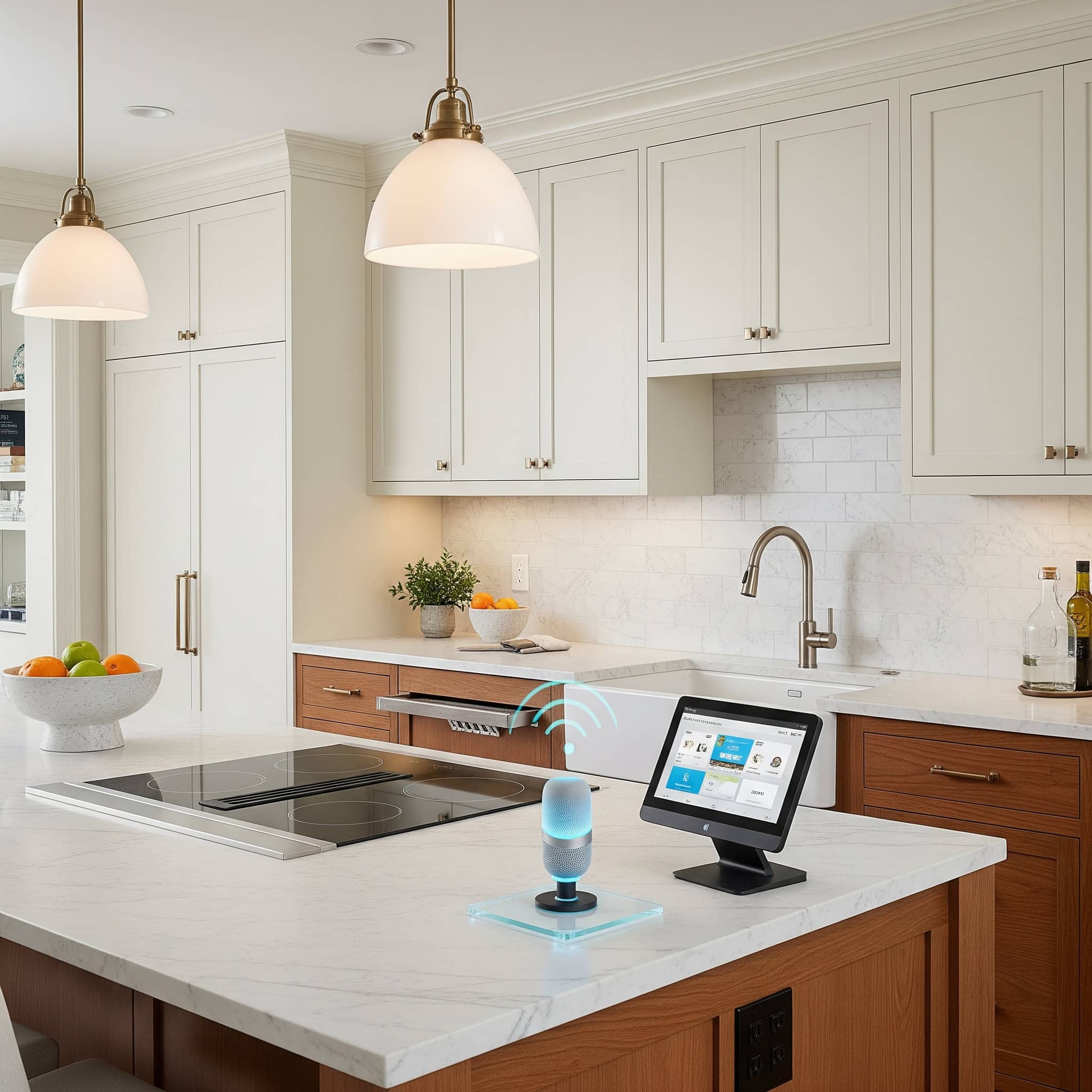25 Stunning Kitchen Ideas for 2025: Transform Your Culinary Space
Table of Contents
-
Considerations for Kitchen Design
-
Sustainable Kitchen Solutions
-
Smart Kitchen Technology
-
Modern Design Aesthetics
-
Functional Layout Innovations
-
Innovative Materials
-
How Jiffy Junk Can Help With Your Kitchen Renovation
-
Final Thoughts
Considerations for Kitchen Design
Before jumping into specific kitchen ideas, I think it’s crucial to understand what factors will shape your renovation decisions. Your kitchen design should strike that perfect balance between functionality, available space, and budget while addressing your specific lifestyle needs.
The kitchen work triangle remains fundamental to good kitchen design. This principle ensures you can move efficiently between your sink, stove, and refrigerator without obstacles. I’ve found that kitchens that ignore this basic concept often feel frustrating to work in, no matter how beautiful they look in photos.
When planning your budget, I always recommend prioritizing structural elements and quality appliances first. These provide the foundation for a functional kitchen and are significantly more expensive to replace later. You can always upgrade decorative elements over time, but that Sub-Zero refrigerator or custom cabinetry? Those are investments worth making upfront in your modern kitchen renovation.
|
Design Factor |
Importance |
Considerations |
|---|---|---|
|
Functionality |
High |
Work triangle, storage needs, number of users |
|
Space |
Medium-High |
Available square footage, ceiling height, load-bearing walls |
|
Budget |
Variable |
Allocation between structure, appliances, finishes |
|
Lifestyle |
High |
Cooking frequency, entertaining needs, accessibility requirements |
|
Maintenance |
Medium |
Time available for cleaning, durability requirements |
Sustainable Kitchen Solutions
1. Eco-Friendly Countertops
I’ve seen a huge shift toward environmentally responsible alternatives to traditional countertop materials in recent kitchen ideas. Options like recycled glass surfaces, bamboo, reclaimed wood, and compressed paper countertops offer both style and sustainability.
Recycled glass countertops contain up to 80% post-consumer recycled content, making them an excellent eco-friendly choice for your kitchen. What I love about these surfaces is that they’re non-porous, so they don’t require sealing and naturally resist stains and bacteria growth. The visual appeal is undeniable, though they typically come with a higher price tag than conventional options.
For those looking for something truly innovative, compressed paper countertops like PaperStone deserve consideration. These are made from 100% post-consumer recycled paper bonded with petroleum-free resins. They can withstand heat up to 350°F and only need occasional oil treatments to maintain their appearance. I’ve seen these in kitchens of all sizes, and they add a warm, unique texture that’s impossible to achieve with traditional materials.
2. Energy-Efficient Appliance Suites
Investing in energy-efficient appliances for your kitchen significantly reduces your environmental footprint while lowering those monthly utility bills. ENERGY STAR certified refrigerators use approximately 9% less energy than standard models, saving an average of $220 over the appliance’s lifetime.
I’m particularly impressed with induction cooktops, which are 85-90% energy efficient compared to just 40% for gas and 70% for traditional electric options. Beyond efficiency, they cook faster and produce less ambient heat in the kitchen—a welcome bonus during summer months!
A family in Portland replaced their 15-year-old appliances with an ENERGY STAR suite including an induction range, refrigerator, and dishwasher. Their monthly utility bills dropped by $45 on average, giving them a complete return on their additional investment within 3.5 years. They told me they’ve noticed faster cooking times, more consistent refrigeration temperatures, and cleaner dishes with less water usage—practical benefits beyond just the environmental impact.
3. Water-Saving Fixtures
Modern water-saving fixtures help conserve this precious resource without compromising functionality in your kitchen. I’ve installed touchless faucets with aerators in several kitchen renovations, and the difference is remarkable. These aerators can reduce water flow from the standard 2.2 gallons per minute to 1.5 GPM or less, potentially saving thousands of gallons annually without any noticeable performance differences.
Touchless faucets are another game-changer for kitchen water conservation. They typically reduce water consumption by 30-50% by eliminating running water during hand washing and food prep transitions. I love how they enhance both sustainability and hygiene in one simple upgrade.
When selecting water-saving fixtures, consider that they not only conserve resources but also add value to your home. As noted in our guide on appliance recycling, upgrading to more efficient fixtures often means responsibly disposing of old ones.
4. Composting Stations
Integrated composting stations help reduce kitchen waste while creating valuable material for gardens. I’ve found that under-counter composting systems can process up to 120 pounds of food waste monthly, reducing household waste volume by approximately 30%. That’s a significant impact from a relatively small kitchen addition!
The technology behind modern composting systems has improved dramatically. Charcoal filter systems use activated carbon that effectively absorbs ethylene gas and other odor-causing compounds, allowing compost collection without noticeable smells for up to 6 months before filter replacement. This makes composting practical even in smaller kitchens where odor concerns might otherwise be prohibitive.
Whether you opt for an under-counter bin, a countertop collector with odor-controlling filters, or a pull-out drawer system, these affordable additions work in most kitchens and significantly enhance your home’s sustainability profile.
5. Recycled Material Cabinetry
Cabinets made from reclaimed wood, recycled metal, or eco-MDF provide sustainable alternatives to conventional cabinetry in modern kitchen design. Eco-MDF contains up to 100% post-industrial wood fiber and uses formaldehyde-free binders, significantly reducing indoor air pollutants compared to standard MDF.
What fascinates me about reclaimed wood cabinetry is that it often features growth rings indicating old-growth timber (80+ years), providing superior dimensional stability and resistance to warping compared to newer wood products. The character and history embedded in these materials create kitchen ideas with depth and story that new materials simply can’t match.
When upgrading to recycled material cabinetry, you’ll need to properly dispose of your old cabinets. Our article on eco-friendly trash removal services explains how to ensure your renovation waste is handled responsibly.
Smart Kitchen Technology
6. Voice-Activated Assistants
Built-in voice assistants have transformed how I interact with my kitchen, allowing hands-free control of lighting, appliances, and access to recipes. Voice recognition systems now achieve 95%+ accuracy rates, even in noisy kitchen environments with multiple sound sources. This reliability makes them practical for everyday use, not just a novelty.
Integration hubs can connect with over 50,000 smart devices across different manufacturers, allowing centralized control of diverse kitchen technologies. I’ve found this particularly useful when combining products from different brands—your Philips Hue lighting can work seamlessly with your Samsung refrigerator and GE oven through a single voice command.
These systems enhance modern kitchen functionality regardless of size but do require reliable Wi-Fi connectivity and some technical knowledge. The initial costs range from moderate to high, but the convenience benefits are substantial, especially when you’re elbow-deep in bread dough and need to preheat the oven!
7. Smart Refrigerators
Advanced refrigerators now offer inventory tracking, expiration notifications, and touchscreens for recipes or family communications. I’m impressed by how internal cameras with AI recognition can identify over 100 common food items automatically, tracking freshness and suggesting recipes based on available ingredients.
Smart refrigerators typically include temperature zones that can be independently controlled within 1°F precision, optimizing storage conditions for different food categories. This precision helps extend the life of your groceries and reduces food waste—something I’ve noticed makes a real difference in my monthly grocery budget.
When upgrading to a smart refrigerator, you’ll need to properly dispose of your old unit. Our guide on preparing refrigerator pickup provides essential steps to ensure your old appliance is handled safely and responsibly.
8. Automated Lighting Systems
Smart lighting enhances both functionality and atmosphere in your kitchen. LED systems consume up to 75% less energy than incandescent lighting while lasting 25 times longer, with quality systems maintaining 70% of original brightness after 50,000 hours of use. That’s over 17 years of daily use for 8 hours!
What I find particularly innovative are advanced lighting systems that can be programmed with circadian rhythms, automatically adjusting color temperature throughout the day to support natural sleep patterns. Cooler, energizing light in the morning gradually shifts to warmer, more relaxing tones in the evening.
|
Smart Lighting Type |
Primary Benefit |
Installation Complexity |
Average Cost |
|---|---|---|---|
|
Motion-sensor under-cabinet |
Task illumination without switches |
Low |
$15-50 per linear foot |
|
Color-changing ambient |
Mood setting and circadian support |
Medium |
$150-300 per fixture |
|
Smart bulb replacements |
Simple upgrade with scheduling |
Very Low |
$25-60 per bulb |
|
Integrated system with hub |
Complete automation and scenes |
High |
$500-2000 for kitchen |
|
Voice-controlled switches |
Hands-free operation |
Medium |
$50-100 per switch |
9. Connected Cooking Appliances
Modern ovens, cooktops, and small appliances offer remote control, guided cooking, and automatic setting adjustments. I’ve tested several connected ovens with internal temperature probes that can maintain cooking temperatures within ±2°F and automatically adjust cooking methods based on internal food temperature readings. The precision is remarkable—no more overcooked roasts or undercooked poultry!
Smart small appliances can receive firmware updates that add new cooking functions and recipes over time, extending the useful life of the product beyond traditional appliances. I recently updated my smart multicooker and gained five new cooking programs that weren’t available when I purchased it two years ago.
These connected appliances range from moderate to high cost but dramatically improve cooking precision and convenience in your modern kitchen design. They’re ideal for busy households and serious cooks who want consistent results with minimal monitoring.
10. Touchless Technology
Touchless features enhance hygiene and convenience throughout your kitchen. Touchless systems typically activate within 100 milliseconds of motion detection, with sensors that can distinguish between intentional activation and background movement. This responsiveness makes them practical for everyday use, not just a fancy gimmick.
Push-to-open mechanisms for cabinets and drawers can support up to 100 pounds of contents while requiring less than 2 pounds of pressure to activate. I’ve installed these in several kitchens and found them particularly useful for accessing trash bins or recycling when hands are full or messy.
For a truly modern kitchen experience, touchless technology can significantly improve both functionality and hygiene. When implementing these features as part of your renovation, consider our tips on how to clean out an office which offers valuable strategies for keeping workspaces sanitary that can be applied to kitchen environments as well.
Modern Design Aesthetics
11. Two-Tone Cabinetry
Two-tone cabinet designs create visual interest and dimension in your kitchen design. Color psychology research indicates that two-tone designs with darker lower cabinets create a sense of grounding and stability while lighter upper cabinets enhance perceived ceiling height. I’ve used this approach in smaller kitchens with dramatic results—the space instantly feels larger and more designed.
The contrast between cabinet sections can be achieved through different paint finishes (matte vs. gloss) even when using the same color, creating subtle visual interest through light reflection differences. This approach works particularly well for those who prefer a monochromatic palette but still want some visual complexity in their kitchen design.
Popular combinations I’ve seen include navy lower cabinets with white uppers, black islands with light perimeter cabinets, or wood lowers with painted uppers. This approach works in most kitchen sizes and can be achieved at various price points, adding designer appeal without requiring a complete overhaul.
12. Statement Backsplashes
Bold backsplashes serve as focal points that elevate your kitchen’s design. I’ve become a huge fan of large-format porcelain panels (up to 5’×10′) that minimize grout lines, reducing cleaning maintenance by up to 80% compared to traditional tile installations. These panels offer the look of natural stone or concrete without the maintenance concerns.
Dimensional tile backsplashes with relief patterns create varying shadow effects throughout the day as natural light changes, providing an ever-changing visual experience. I installed these in my own kitchen and find myself noticing new details depending on the time of day and lighting conditions.
A small galley kitchen in a Chicago apartment was transformed by installing a dramatic backsplash featuring handmade Moroccan zellige tiles in a deep emerald green. The homeowner kept all existing white cabinets and neutral countertops but replaced the standard subway tile backsplash. This single change cost approximately $1,800 but completely transformed the space, creating a luxurious focal point that draws the eye and distracts from the kitchen’s limited square footage.
13. Mixed Metals
Combining different metal finishes creates a sophisticated, layered look in your kitchen design. The most successful mixed metal designs follow the 60-30-10 rule: 60% dominant metal (typically appliances), 30% secondary metal (often faucets and lighting), and 10% accent metal (hardware and small details). This proportion ensures the mix feels intentional rather than haphazard.
PVD (Physical Vapor Deposition) finishes on metal fixtures provide up to 10 times the wear resistance of traditional plating, maintaining appearance despite frequent contact and cleaning. I always recommend these finishes for frequently used items like faucets and cabinet pulls in kitchens.
Brass fixtures with stainless appliances or copper hoods with black hardware offer pleasing contrast while maintaining cohesion. This trend accommodates various budgets and kitchen sizes, allowing for personalization without major structural changes.
14. Minimalist Open Shelving
Open shelving creates visual spaciousness while showcasing beautiful dishware in modern kitchens. Properly installed floating shelves using concealed steel brackets can support up to 50 pounds per linear foot while maintaining a clean, hardware-free appearance. This weight capacity means you can confidently display your collection of cast iron cookware or stoneware dishes without worry.
Open shelving reduces cabinet material costs by 30-40% compared to traditional upper cabinets, while potentially increasing resale appeal through perceived spaciousness. I’ve found this particularly effective in smaller kitchens where traditional upper cabinets can feel imposing or claustrophobic.
Floating wooden shelves, metal bracket systems, or glass display shelving all offer storage with style. This budget-friendly option works best for organized homeowners with attractive kitchenware, though it requires more frequent cleaning and thoughtful arrangement. Are you ready to keep your displays looking Instagram-worthy? If not, this might not be the right choice for your kitchen.
15. Statement Range Hoods
Distinctive range hoods serve as architectural focal points in modern kitchen design. Professional-grade hood ventilation systems extract 600-1200 CFM (cubic feet per minute) of air, completely exchanging kitchen air 15+ times per hour to remove cooking odors, moisture, and particulates. This powerful ventilation makes a real difference in air quality, especially for those who cook frequently with high-heat methods.
Custom metal hoods in materials like hammered copper develop unique patinas over time through oxidation, creating one-of-a-kind finishes that cannot be replicated artificially. I’ve watched clients’ copper hoods evolve over years, becoming more beautiful and unique with each passing month.
Custom metal designs, integrated wooden structures, or sculptural ceramic versions all create strong visual impact. These significant investments work best in kitchens with adequate ceiling height and proper ventilation infrastructure, balancing form with essential function.
Functional Layout Innovations
16. Double Islands
Dual island configurations separate prep work from dining or entertaining, enhancing workflow and social interaction in your kitchen. Optimal double island designs maintain 42-48 inches of clearance between islands and between islands and perimeter counters, ensuring comfortable circulation for multiple users. I’ve found this clearance essential—anything less creates bottlenecks during busy cooking sessions.
Secondary islands typically incorporate different counter heights (36″ for prep vs. 42″ for dining) and different materials to visually distinguish their functions. This differentiation helps guests intuitively understand which spaces are for working and which are for gathering, reducing awkward “am I in your way?” moments during entertaining.
This feature requires substantial square footage and a higher budget but dramatically improves functionality for households that frequently entertain. The separation of work zones allows multiple cooks to function efficiently without crowding—perfect for collaborative holiday meal preparation or cooking classes with friends.
17. Hidden Pantry Doors
Concealed pantry entrances maximize storage while maintaining clean design lines in kitchens. Hidden door systems typically use specialized hardware rated for 80,000+ opening cycles, with weight capacities up to 300 pounds to support fully loaded pantry doors. This durability ensures your clever design feature remains functional for decades of daily use.
Pressure-release mechanisms in concealed doors prevent air pressure differentials that could cause unintended opening or closing when primary kitchen doors are used. I’ve seen poorly designed hidden doors swing open unexpectedly when exterior doors close—these mechanisms eliminate that problem entirely.
Options include cabinet-matching doors, bookcase entries, or sliding wall systems that disappear when open. These kitchen ideas require planning during renovation and moderate to high budget allocation but provide substantial storage capacity without visual clutter. Have you ever wished you could hide away all your small appliances and pantry items while maintaining a sleek, minimalist kitchen? Hidden pantry doors make this possible.
18. Dedicated Beverage Stations
Specialized drink areas keep beverage preparation separate from cooking activities in your kitchen. Built-in coffee systems connect directly to water lines, eliminating manual filling while incorporating water filtration systems that remove 99% of chlorine and other contaminants. This convenience makes your morning routine significantly more streamlined—no more filling and refilling water reservoirs!
Dedicated beverage refrigerators maintain temperatures between 38-65°F with ±1° precision, offering optimal storage conditions for different beverages compared to standard refrigerators. I’ve found this particularly valuable for wine storage or craft beer collections that benefit from specific temperature ranges.
A family in Denver converted an underutilized corner of their kitchen into a dedicated beverage station that serves multiple functions throughout the day. The 30-inch wide space includes a built-in coffee maker with water line connection, a small refrigerator drawer for milk and cold brew, and a floating shelf for mugs and glasses. In the evening, the same station transforms for cocktail preparation with a small ice maker and storage for spirits. This targeted renovation cost approximately $4,200 but has become the most frequently used area of their kitchen, eliminating counter clutter and creating dedicated space for both morning routines and evening entertaining.
19. Multi-Height Countertops
Varying counter heights accommodate different tasks and users in kitchen design. Ergonomic studies show that optimal working height is approximately 3-4 inches below elbow height, making standard 36″ counters ideal for users 5’4″ to 5’7″ tall but potentially causing strain for others. I’ve incorporated multi-height counters in several kitchens and the feedback is always positive—especially from taller or shorter family members.
Baking centers set at 30-32″ height reduce shoulder strain by 15-20% during activities requiring downward force like kneading and rolling dough. If you’re an avid baker, this single modification can make a tremendous difference in your comfort during marathon baking sessions.
|
Counter Height |
Ideal Usage |
Best For |
Ergonomic Benefits |
|---|---|---|---|
|
28-30 inches |
Baking center |
Dough work, rolling, kneading |
Reduces shoulder strain, allows leverage |
|
34-36 inches |
Main prep area |
Chopping, mixing, general prep |
Standard working height for average adults |
|
38-42 inches |
Breakfast bar/serving |
Casual dining, entertaining |
Minimizes bending for serving, creates visual division |
|
24-26 inches |
Kids’ cooking zone |
Child participation, learning |
Accessible for younger family members |
|
32-34 inches |
Accessible section |
Wheelchair users |
Allows under-counter knee space with proper reach |
20. Appliance Garages
Dedicated storage spaces keep small appliances accessible but hidden in your modern kitchen. Modern appliance garage mechanisms include soft-close dampeners that prevent slamming and reduce wear on moving parts, extending operational life to 20+ years. This durability ensures your investment continues to function smoothly through thousands of opening and closing cycles.
Internal power outlets with surge protection can be installed within appliance garages, allowing devices to remain plugged in but protected when not in use. I’ve found this particularly useful for frequently used items like stand mixers or food processors that are too heavy to move in and out of cabinets regularly.
When designing your kitchen with appliance garages, consider how to properly handle any items you’ll be replacing. Our guide on appliance disposal for refurbished kitchens provides valuable insights on responsibly removing old appliances during your renovation.
Innovative Materials
21. Porcelain Countertops and Surfaces
Large-format porcelain slabs offer exceptional durability and low maintenance for countertops, backsplashes, or cabinet facing in your kitchen. Modern porcelain slabs are manufactured at 1200°C under 15,000 tons of pressure, creating a non-porous surface with zero water absorption and bacterial resistance. This manufacturing process results in a material that’s virtually indestructible in normal kitchen use.
Porcelain’s color stability comes from inorganic pigments that resist UV degradation, maintaining appearance even in kitchens with high sun exposure for 20+ years. I’ve seen porcelain installations that look exactly the same after a decade of heavy use—something that can’t be said for many natural stone options.
These surfaces resist heat, scratches, and stains while providing a range of aesthetic options from marble-look to industrial concrete finishes. They represent a moderate to high investment but deliver excellent longevity and performance in any kitchen size. Have you considered how much time you currently spend maintaining your countertops? Porcelain could dramatically reduce that maintenance burden.
22. Textured Cabinet Finishes
Tactile cabinet surfaces add dimension and visual interest to your kitchen. CNC manufacturing allows precise repetition of textural elements with tolerances of 0.1mm, creating perfectly consistent patterns across multiple cabinet faces. This precision was impossible to achieve with hand-crafted methods, opening new design possibilities for textured finishes.
Textured finishes typically show 30-40% less visible fingerprints and minor scratches compared to smooth surfaces, maintaining appearance with less frequent cleaning. I’ve installed fluted panels in high-traffic kitchen areas specifically for this practical benefit—they look cleaner longer, even with children around.
Fluted wood panels, ribbed glass inserts, or matte finishes with subtle texture create sensory richness in kitchen ideas. These details can be incorporated at various price points and in any kitchen size, often serving as focal points in otherwise simple designs. Would you rather run your hand across a perfectly smooth cabinet door or one with subtle, tactile dimension? Most people find textured surfaces more engaging and luxurious.
23. Concrete Elements
Polished concrete brings industrial character and exceptional durability to countertops, sinks, or flooring. Modern concrete countertops incorporate glass fiber reinforcement that increases flexural strength by 300% compared to traditional concrete, reducing cracking risk. This engineering advancement has transformed concrete from a risky choice to a reliable option for kitchen surfaces.
Advanced concrete sealers create molecular bonds with the concrete surface, providing stain protection that penetrates up to 5mm deep rather than just coating the surface. I’ve spilled red wine and tomato sauce on properly sealed concrete counters with zero staining—a level of protection that wasn’t possible with earlier sealing technologies.
This material offers unique aesthetic appeal and performance benefits but requires professional installation and proper sealing. Concrete works in most kitchen designs but adds considerable weight, sometimes necessitating structural reinforcement. Have you considered the character that concrete could bring to your space? Its subtle variations and ability to be customized with aggregates, pigments, or embedded objects make each installation truly one-of-a-kind.
24. Natural Stone Sinks
Integrated sinks carved from marble, granite, or soapstone create striking focal points with practical functionality in modern kitchens. Natural stone sinks are typically carved from single blocks weighing 300-500 pounds before fabrication, ensuring structural integrity without seams or weak points. This solid construction creates a sink that can last for generations with proper care.
Stone sink materials vary significantly in hardness: granite measures 6-7 on the Mohs scale, marble 3-4, and soapstone 1-2, affecting durability and maintenance requirements. I always discuss these differences with clients to ensure they choose a material that matches their lifestyle and maintenance preferences.
These statement pieces require higher budgets but offer unique aesthetic appeal that mass-produced options cannot match. They need proper sealing and maintenance but provide lasting impact and authentic character in your kitchen. When was the last time a sink made you stop and admire its beauty? Natural stone sinks have that power.
25. Antimicrobial Surfaces
Hygiene-enhancing materials provide peace of mind in food preparation areas of your kitchen. Copper surfaces have been shown to eliminate 99.9% of bacteria within two hours of exposure, with antimicrobial properties that never diminish over the material’s lifetime. This natural antimicrobial action works continuously, even when you’re not actively cleaning.
Silver ion technology works by disrupting bacterial cell membranes and interfering with DNA replication, preventing microorganisms from reproducing on treated surfaces for 3-5 years before reapplication may be needed. I’ve seen this technology incorporated into everything from cabinet pulls to cutting boards with impressive results.
A homeowner in Austin transformed their kitchen with antimicrobial surfaces after researching health-conscious renovations. They installed copper-infused quartz countertops and chose cabinet hardware with silver ion treatment. The family, which includes a member with autoimmune concerns, reported greater peace of mind during food preparation. While the antimicrobial materials added approximately 15% to their overall renovation budget, they considered it an essential investment in their family’s health. Regular testing with ATP meters confirmed bacterial loads remained significantly lower than in their previous kitchen, especially around high-touch areas like sink edges and refrigerator handles.
How Jiffy Junk Can Help With Your Kitchen Renovation
Before implementing any of these exciting kitchen ideas, you’ll need to clear out your existing space. Professional junk removal services can typically clear a complete kitchen in 2-4 hours, compared to 1-2 days for DIY removal, significantly accelerating your renovation timeline. I’ve seen this difference firsthand—professional teams have the equipment and experience to work efficiently without damaging your home.
Proper disposal of kitchen materials involves separating up to 12 different material streams (various metals, woods, plastics, etc.) to maximize recycling potential, a process Jiffy Junk has optimized. This detailed sorting ensures that as much material as possible is recycled or repurposed rather than ending up in landfills.
When planning your kitchen renovation, proper disposal of old materials is crucial. Our furniture removal guide provides valuable information on how to responsibly remove old kitchen cabinets and other furnishings, ensuring your renovation starts with a clean slate and minimal environmental impact.
Final Thoughts
Creating your dream kitchen for 2025 requires balancing aesthetic trends with practical functionality. Kitchen renovations typically return 70-80% of their cost in home value, making them one of the most financially sound home improvements when properly executed. I’ve seen this return on investment consistently across different housing markets and price points.
The average kitchen remodel takes 6-8 weeks from demolition to completion, with proper planning and material pre-ordering potentially reducing this timeline by 30%. Planning ahead is crucial—especially with current supply chain challenges affecting certain materials and appliances.
By carefully evaluating each kitchen idea against your specific needs, preferences, and constraints, you’ll develop a renovation plan that delivers lasting satisfaction. What aspects of your current kitchen frustrate you the most? Which activities do you perform most frequently? Answering these questions will help you prioritize the innovations that will make the biggest difference in your daily life.
Remember that successful kitchen designs prioritize both beauty and usability, creating spaces that enhance your daily experience for years to come.


